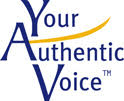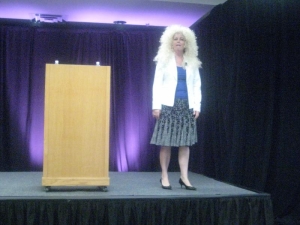Some people are naturals. Truly. I watched one guy at my Toastmasters Club. He had the room rolling in the aisles. His creativity was off the charts and it was completely natural. Unless he is secretly a well-rehearsed stand-up comedian, his brain just works that way. He is a sight to behold. Most of the rest of us have to be a little more purposeful when adding humor.
| While telling a story about a very embarrassing moment, I used a prop — a wig that resembled my hair at that time. I used exaggeration (although not much) and self-deprecation. Got a lot of laughs! |
This is important, because humor can be the best thing you do, or the worst, and I know you know what I’m talking about! Have you ever been in the audience when someone tells a really off-color joke, or an offensive story, thinking he or she is adding humor? Painful, really painful.
Humor truly is the last frontier for most presenters. And like the famous dodo bird, it can be just as elusive. To support your efforts to bring not only information and inspiration, but also entertainment and joy to your listeners, here are several techniques you can use:
1. Find humor in your stories. It’s there because we are funny beings. We just have to be open to it. For example, when you are sharing details about where your story takes place, share the quirkiness, the weirdness or the altogether odd things about your location. You just have to notice. When you talk about yourself, or the characters in your story, bring them to life by noticing something unusual. In one of my stories, I reference a man I met in Athens as looking rather swarthy, like one of the pirates in the Pirates of the Caribbean movies, but not like Johnny Depp — one of the other guys! Always garners a laugh. My only warning — make sure your humor is grounded in good will. Don’t make fun of others or put them down. Treat people with respect, including yourself!
2. Better than jokes, incorporate one-liners. Cavett Robert, founder of the National Speakers Association, used to collect one-liners and sprinkle them throughout his speeches. His daughter, Lee, suggested I use this technique with one of my leadership speeches, and I did! I had already come up with a pretty funny title: This Would Be Really Funny If It Weren’t Happening to Me! The Three Essential Truths of Leadership. I then introduced each of my points with a one-liner and went on to share the information and stories. It killed! Here’s an example:
One-liner: I can please only one person per day. Today is not your day. Tomorrow’s not looking good either.
The point: Leadership is not about pleasing people. It’s about serving people.
3. Use self-deprecating (not demeaning) humor.Say something about yourself that might not be the most wonderful aspect of your personality, but something we can all relate to. The other day I was doing a training on networking and I mentioned there are days I just don’t want to meet anyone! I’d rather go home, take off my heels and eat chocolate. When I combined this comment with lots of exaggerated slumping, sighing and whining, everyone laughed because we all feel that way at times! You also communicate that you don’t take yourself that seriously, and that’s good!
4. Use metaphors and similes to create funny relationships. My toastmaster friend compared using hot peppers on his food to putting kitty litter on his ice cream! He also said eating peppers felt like stepping into Johnny Cash’s song, Ring of Fire. Very creative and everyone got the picture. If you don’t want to do this, you can use videos or cartoons to make your points. These are always fun if you choose wisely and get permission. I always laugh at the screaming goats!
5. Use exaggeration in your language and with your body, your facial expressions, your vocal variety, and your pacing. Bring your presentation to life. Let your audience in by exaggerating your experience through novelty and drama.
Humor is a great resource for presenters. Here’s my only caveat: if in doubt, try it out! Tell your story, your one-liner, or your metaphor to a couple of people and see how they respond. Ask for honest feedback. The worst that can happen is it doesn’t work and you need to try something else. That’s better than dying on stage!
Getting a laugh when you intend to (and sometimes when you don’t) is a rewarding experience. It breaks the ice and opens the door to a deeper connection with your audience. Have fun with it. It truly is the last frontier to being a great speaker!
I’d love to support you to discover how you can lighten up and get those belly laughs. You can reach me atAndrea@AndreaBeaulieu.com.


Leave A Comment